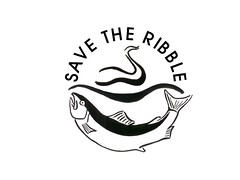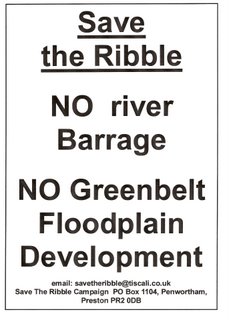Pro-River Campaigns Around The World
When we at “Save The Ribble’ first began our campaign almost a year ago exactly, we thought we were just an isolated case of a local community and it’s river under threat from an undemocratic alliance of local politicians, officials and developers.
As we have continued our campaign, we have quickly learned that we are not on our own, and that all around the world, rivers, the people who live nearby and the eco-diversity they support face very similar challenges to those faced by the people living near the Ribble.
 Save The Mary River Campaigners
Save The Mary River CampaignersFor example, in Australia, local people are resisting a huge project to dam the Mary River: they have set up The Save The Mary River Campaign, they say:
“The more that is known about the Traveston Crossing Dam proposal on the Mary River, the worse it looks Queensland Premier Mr. Peter Beattie announced on Thursday, 27th April 2006 that the Queensland Government proposes to build a mega-dam (more than 1.3 times the area of Sydney Harbour) on the Mary River at Traveston Crossing that will inundate the central Mary Valley in Queensland's Sunshine Coast hinterland and re-direct the water of the Mary River catchment into Brisbane. Until the announcement, no information had been made public about ANY planning procedures or studies to justify the decision. There had been absolutely NO public consultation with any of the local stakeholders regarding this decision before the announcement.
The State Government's own scientific evidence indicates that this proposal would seriously degrade the 200km of river downstream of the proposal and greatly effect the Great Sandy Straits by stopping all fresh water flow to the sea from the river for a significant proportion of the time. Independant economic analysis now shows that the proposal is an extremely high risk, high cost strategy compared to other viable means of providing for urban water supply in SE Qld, and would produce water that will cost the public significantly more than most of the other viable options investigated. Reputable academic studies assessing social impact of the way the project has been implemented to date have been condemnatory in their conclusions.
It still looks as if the decision to spend billions of dollars of public money on a potential environmental and social disaster has been made on the basis of political expediency rather than good science, engineering and planning.
Read more at Traveston Swamp News
 Image from www.riosvivos.org.br
Image from www.riosvivos.org.brMeanwhile people in the La Plata Basin in Paraguay are resisting plans to turn their river into an industrial shipping channel.
“scientists predict that the channelization of the Paraguay River would cause the wetlands to shrink, with associated losses in biodiversity”
The preservation of wetlands is also a key issue for the future of the Ribble - these would be drowned upriver of a barrage, and starved of the silts that nourish them downriver.
People in China face an even more massive, threat, from the ‘Three Gorges Dam Project’

According to the International Rivers Network:
“The (three gorges) project has been plagued by massive corruption problems, spiraling costs, technological problems, human rights violations and resettlement difficulties. One million people have been displaced by the dam as of 2006; many are living under poor conditions with no recourse to address outstanding problems with compensation or resettlement. Said one peasant from Kai county, "We have been to the county government many times demanding officials to solve our problems, but they said this was almost impossible. They have threatened us with arrest if we appeal for help from higher government offices."
The dam is having terrible effects on the environment as well as the people:
“The dam is also affecting one of the world’s biggest fisheries in the East China Sea. Scientists estimate that annual catches may be reduced by one million tons due to the decline in fresh water and sediment reaching the sea. The Yangtze delta and tidal wetlands are already being badly eroded the loss of sediment.”
This is very similar to the potential consequences of a Ribble barrage, which would cut of the flow of silts to the environmentally significant Ribble Estuary and the Ribble Estuary Wetland Park.
Another set of dams threatens the River Narmada in central India

Campaigners demonstrated and fasted against the Narmada dam project
Campaigners against this project argue
“A quick look at the ground reality would disabuse anyone of the real nature of the dam-builder's enterprise. Large dams imply large budgets for related projects leading to large profits for a small group of people. A mass of research shows that even on purely technical grounds, large dams have been colossal failures. While they have delivered only a fraction of their purported benefits, they have had an extremely devastating effect on the riverine ecosystem and have rendered destitute large numbers of people (whose entire sustenance and modes of living are centered around the river). For no large dam in India has it been shown that the resettled people have been provided with just compensation and rehabilitation.”
There are also campaigns sparking off to destroy existing dams and barrages; the American group Taxpayers for Common Sense argue for the destruction of 4 dams on the Snake River.
They say:
Several stocks of Lower Snake River salmon and steelhead are already extinct or headed to extinction. Removing the four hydroelectric dams on the Lower Snake River in eastern Washington State is the only way to save the fish...
The sooner the dams are removed, the better. They are the key barrier to a crucial ecosystem – the pristine fish spawning grounds above the dams and the estuaries that lead to the Pacific Ocean. Environmentalists, Native Americans and commercial and sport fishing interests all have a special interest in the fish and the ecosystem.
Around the world, experts and now some governments are beginning to realise that as well as being environmentally destructive, and socially damaging to local people BARRAGES AND DAMS ARE EXPENSIVE - they neccessitate dredging and groundwater pumping which can cost £millions every year - of course it is the taxpayers who end up carrying this economic burden, when the developers have long since departed, with pockets full of cash.
There is lots of information on the economic costs of dams and on the benefits of destroying them in the “River Revival Bulletin”:
and also here

Dam being decommissioned
© Roberto Epple, ERN
It is great to know we are part of a worldwide pro-river movement, and we are sure that if enough people mobilise and explain the true social, economic and environmental costs of barrages and dams, we can gradually turn the tide against unsound and irresponsible dam and barrage projects, including the Riverworks Barrage.
Labels: dam, direct action, International, River















1 Comments:
Thank you for raising awareness of the problems we face world wide. The authorities need to take notice and stop destroying rivers. Keep up the good work.
arawajo, Australia.
Post a Comment
<< Home